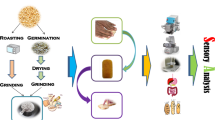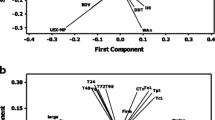Summary
The non-starch polysaccharide (NSP) content and composition of rye flours, differing in baking quality, were studied over three consecutive years at three locations. Rye flours were rich in water-extractable NSP and, consequently, rich in water-extractable arabinoxylans (WE-AX). A large variability of both components was observed in water-unextractable fraction, and especially, in the ratio of water-extractable to water-unextractable arabinoxylan content (WE/U-AX). The proportion of WE/U-AX in rye flour was found to be the primary factor contributing to both flour and bread quality parameters. However, the content of WE-AX correlated positively but not significantly, whereas water-unextractable (WU) counterpart was negatively correlated with quality attributes. The data showed that rye flour of high baking quality had a high ratio of WE/U-AX, which was also combined with high values of falling number and amylographic peak viscosity. Significant, positive correlations were also found between ratio of water extract viscosity to water-extractable arabinoxylan content (EV/WE-AX) and overall baking score and bread volume. Our results suggest that some AX populations, of specific structure and/or molecular weight, could be especially important for baking potential of rye flour.
Similar content being viewed by others
References
Bach Knudsen, K.E. and Li, B.W., 1991.: Determination of oligosaccharides in protein-rich feedstuff’s by gas-liquid chromatography and high-performance liquid chromatography. Journal of Agricultural and Food Chemistry 39: 689–694.
Bengtsson, S., Andersson, R., Westerlund, E. and Åman, P., 1992.: Content, structure and viscosity of soluble arabinoxylans in rye grain from several countries. Journal of the Science of Food and Agriculture 58: 331–337.
Boros, D., Marquardt, R.R., Slominski, B.A. and Guenter, W., 1993.: Extract viscosity as an indirect assay of water-soluble pentosan content in rye. Cereal Chemistry 70: 575–580.
Courtin, C.M., Roelants, A. and Delcour, J.A., 1999.: Fractionation - reconstitution experiments provide insight into role of endoxylanases in bread-making. Journal of Agricultural and Food Chemistry 47: 1870–1877.
Cyran, M., Rakowska, M., Wasilewko, J. and Buraczewska, L., 1995.: Degradation of dietary fibre polysaccharides of rye in the intestinal tract of growing pigs used as a model animal for studying digestion in humans. Journal of Animal and Feed Sciences 4: 217–227.
Englyst, H.N. and Cummings, J.H., 1984.: Simplified method for the measurement of total non-starch polysaccharides by gas-liquid chromatography of constituent sugars as alditol acetates. Analyst 109: 937–942.
Fincher, G.B. and Stone, B.A., 1986.: Cell walls and their components in cereal grain technology. In ‘Advances in Cereal Science and Technology, Volume VIII’ (Y. Pomeranz, ed.), American Association of Cereal Chemists, Inc., St.-Paul, Minnesota, U.S.A. pp 207–295.
Fry, S.C., 1986.: Cross-linking of matrix polymers in the growing cell walls of angiosperms. Annual Review of Plant Physiology 37: 165–186.
Geissmann, T. and Neukom, H., 1973.: On the composition of the water-soluble wheat flour pentosans and their oxidative gelation. Lebensmittel–Wissenschaft und Technologie - Food Science and Technology 6: 59–62.
Grabber, J.H., Hatfield, R.D. and Ralph, J., 1998.: Diferulate cross-links impede the enzymatic degradation of non-lignified maize walls. Journal of the Science of Food and Agriculture 77: 193–200.
Gråsten, S.M., Juntunen, K.S., Poutanen, K.S., Gylling, H.K., Miettinen, T.A. and Mykkänen, H.M., 2000.: Rye bread improves bowel function and decreases the concentrations of some compounds that are putative colon cancer risk markers in middle-aged women and men. Journal of Nutrition 130: 2215–2221.
He, H. and Hoseney, R.C., 1991.: Gas retention of different cereal flours. Cereal Chemistry 68: 334–336.
Kato, Y., Yamanouchi, H., Hinata, K., Ohsumi, C. and Hayashi, T., 1994.: Involvement of phenolic esters in cell aggregation of suspension-cultured rice cells. Plant Physiology 104: 147–157.
Madej, L., Raczynska-Bojanowska, K. and Rybka, K., 1990.: Variability of the content of soluble non-digestible polysaccharides in rye inbred lines. Plant Breeding 104: 334–339.
Marchello, J.A., Dryden, F.D. and Hale, W.H., 1971.: Bovine serum lipids. I. The influence of added animal fat to the ration. Journal of Animal Science 32: 1008–1015.
Meuser, F. and Suckow, P., 1986.: Non-starch polysaccharides. In ‘Chemistry and Physics of Baking’ (J.M.V. Blanshard, P.J. Frazier and T. Galliard, eds), The Royal Society of Chemistry, London, U.K. pp 42–61.
Nilsson, M., Åman, P., Härkönen, H, Hallmans, G., Knudsen, K.E.B., Mazur, W. and Adlercreutz, H., 1997.: Nutrient and lignan content, dough properties and baking performance of rye samples used in Scandinavia. Acta Agriculture Scandinavica 47: 26–34.
Plaami, S., Saastamoinen, M. and Kumpulainen, J., 1989.: Effects of variety and environment on dietary fibre content of winter rye in Finland. Journal of Cereal Science 10: 209–215.
Ragaee, S.M., Campbell, G.L., Scoles, G.J., McLeod, J.G. and Tyler, R.T., 2001.: Studies on rye (Secale cereale L.) lines exhibiting a range of extract viscosities. 1. Composition, molecular weight distribution of water extract, and biochemical characteristics of purified water-extractable arabinoxylan. Journal of Agricultural and Food Chemistry 49: 2437–2445.
Rakowska, M., Raczynska-Bojanowska, K. and Kupiec, R., 1992.: Studies on the antinutritive compounds in rye grain. V. Effect of polysaccharides complex on protein digestibility and feed utilization. Polish Journal of Food and Nutrition 1/42: 95–102.
Roehring, K.L., 1988.: The physiological effects of dietary fiber - a review. Food Hydrocolloids 2: 1–18.
Saastamoinen, M., Plaami, S. and Kumpulainen, J., 1989.: Pentosans and ß-glucan content of Finnish winter rye varieties as compared with rye of six other countries. Journal of Cereal Science 10: 99–207.
Seibel, W. and Weipert, D., 2001.: Bread baking and other food uses around the world. In ‘Rye: Production, Chemistry and Technology’ (W. Bushuk, ed.), American Association of Cereal Chemists, Inc., St.-Paul, Minnesota, U.S.A. pp 147–211.
Smith, M.M. and Hartley, R.D., 1983.: Occurrence and nature of ferulic acid substitution of cell-wall polysaccharides in graminaceous plants. Carbohydrate Research 118: 65–80.
Author information
Authors and Affiliations
Corresponding author
Rights and permissions
About this article
Cite this article
Cyran, M., Cygankiewicz, A. Variability in the Content of Water-Extractable and Water-Unextractable Non-Starch Polysaccharides in Rye Flour and Their Relationship to Baking Quality Parameters. CEREAL RESEARCH COMMUNICATIONS 32, 143–150 (2004). https://doi.org/10.1007/BF03543292
Received:
Accepted:
Published:
Issue Date:
DOI: https://doi.org/10.1007/BF03543292




